Throughout life, one may encounter a multifaceted complexity in which two opposing sides attempt to determine its meaning, as they endlessly debate their views. The Adventures of Huckleberry Finn, written by Mark Twain, strattles the line between a classic novel and a racist story, leading many to debate its true roots. Twains recurrent use of the "N" word, in addition to his, questionable, inhumanity towards the Negro race, lead many to believe that the book was developed upon racist roots. Throughout the book, Mark Twain develops Jim, a slave character, into a kind compassionate human being, who is willing to sacrifice his freedom to help a friend in need. In addition, Twain allows Jim to think clearer than the free men around him. Also, Twain uses satire to criticize the inhumane treatment given to past day African Americans. Because Twain creates the character of Jim, a slave, as a kind, compassionate, clear thinking individual, who is eventually freed at the end, it is evident that this book is not racist.
Because of Twain's frequent use of the "N" word, in addition to the stereotypical views of blacks and the inhumanity towards them, some depict this book as racist. First, critics agree that Twain consistently uses the "N" word, making the novel appear to be racist and offensive. Wallace argues that because the "N" word literally means "member of any dark-skinned race of people and is offensive," many African Americans who read this book could take offense and therefore declare the novel racist (Wallace 17). In succession, many Caucasians, still ashamed of what their ancestors had done to Africans in the slave times, feel that it is also their place to take offense for African Americans, declaring it a racist novel as well. Some critics believe that Twain creates Jim, a slave, as a piece of property that could be sold and bought. Smiley argues that when the two Mississippi River bandits, traveling with Jim, become short on cash, and "betray Jim by selling him for forty dollars," African Americans are depicted as others" property (Smiley 63). Some people then conclude that Twain believes that there is nothing wrong with human as other's property. Wallace, again, believes that Twain depicts African Americans as inhuman objects, not even worth grieving over. When asked if any injuries had resulted from the recent Steamboat accident, Huck, pretending to be Tom, states that nobody had been hurt however it had "killed a 'N'" (Wallace 21). Many critics think that Twain is referring that African Americans are not human, rather objects. Twains consistent use of the "N" word in addition to his inhuman depiction of African Americans, leads many to criticize the novel as racist.
Throughout the book, Mark Twain develops Jim, a slave character, into a kind compassionate human being, who even sacrifices his own freedom to help a friend. Jim expresses utmost compassion towards his wife and kids, Hoping to one day rejoin them. Along the Mississippi River, Jim would become "low and homesick" for he had been separated from his family and hoped to one day rejoice in their presence (Twain 267). This shows the compassion and love that Jim expresses towards his long lost family. This is significant, for these emotions show Jim as a loving human being, not the soulless emotionless slave that he was commonly viewed as. In consequence, we discover that Twain viewed the slaves as human beings, rather than property, proving that the novel is in fact not racist. In addition, Jim repeatedly surrendered his sleep so that Huck Finn, his new friend, could get more rest. On many occasions "Jim [wouldn't] call [Huck] when it was [Huck's] turn" to keep guard, giving Huck more rest, and yielding his own (Twain 266). While night traveling on the river, someone had to always be on watch for steamboats and other big boats, for they could capsize one's raft. Although Jim and Huck had agreed to split the shifts evenly, Jim continued to take more resulting in self-sacrifice for him, showing that he is generous and unselfish. In consequence, we discover that Twain was built Jim's character into an unselfish, generous man, qualities a slave, in a racist novel, would not have. Furthermore, Jim sacrifices his freedom to help a friend in need. Upon realizing that Tom Sawyer, Jim's friend, was hurt and in need help, Jim willingly came out from hiding, "risking his freedom," to accompany a doctor in curing Tom (Twain 492). Tom had been shot in the process of saving Jim and, therefore, Jim felt it was his duty to save Tom. This is the greatest act of kindness Jim good possibly have shown. He gave up his freedom, the thing he had worked for his whole life, in order to assist his friend. In consequence, the reader realizes that Jim is a full-hearted man, not the selfish pig he should have been made into had this been a racist novel. Twain presents Jim as a kind, compassionate, unselfish individual, qualities that certainly would not serve a slave in a racist novel.
Twain allows Jim to think clearer than the free men around him. When Huck tries to explain to Jim why King Solomon would cut a child in two, Jim doesn't understand. Because King Solomon had proposed to cut a child in two to settle an argument, and Jim could not find any "use in half a chile," Jim became perplexed with Solomon and his theory's (Twain 133). Jim could not find why someone would cut a child in half, for it would solve nothing. This act expresses Jim's compassion, but more of Jim's clear thinking; even if the King has millions of children running around, and cutting one in half would make no difference to him, it would impact the child's family and friends dearly. In consequence, we see that Jim, the slave of the novel, is a clear thinker, capable of leading the novel. In addition, Jim promotes that the whole world should speak the same language. Jim believes that if all men "talked like [men]," meaning they talked the same with the same language, then our world would be a better place (Twain 137). He promotes this idea because he cannot understand why Frenchmen speak differently from Englishmen. This, once again shows Jim's insight and clear thinking. In consequence, Huck does not understand Jim's simple theory proving that Jim is the intellect over Huck. Finally, Jim does not understand why Huck and Tom draw out his escape and make it much harder than it needed to be. Although Tom argued that many pointless things "must a be done" in order for Jim to escape, Jim argued against them for they only prolonged their plan (Twain 450). These things, infesting his quarters with rodents, obtaining a rope ladder through a pie, ect, were pointless fixtures which added no help to Jim's escape. Because of Jim's outcry, we can see that he, unlike the boys, understands the dilemma he is in and how to solve it. By doing this, Jim's superior thinking skills becomes present, making him a true individual. Because Jim has not been hindered by the influence of others' ideas, he can solve many of the world's problems with simple solutions.
Twain uses satire to criticize the inhumane treatment given to past day African Americans. After Huck and Jim had become separated in the fog, Huck plays a practical joke on Jim. When they had passed the fog, Huck insisted that "[Jim] did dream it" although it had actually happened (Twain 145). Once Jim had figured out that Huck had been playing a joke on him, Jim became mad and ashamed of Huck. In effect, Huck felt terrible at what he had done and swore to never make Jim feel bad again. In consequence, this act strengthened Huck and Jim's relationship, resulting in a lasting friendship. Towards the beginning of the book, while Jim is sleeping, Tom removes Jim's hat and places it on a tree branch above him. "Afterwards Jim said that witches bewitched him and put him in a trance," elaborating the story a little more every time he told it (Twain 10). Tom played this trick as he was sneaking out to go play with Huck and others. This shows the amusing humor behind the superstitions of our past time. In consequence, the reader can interpret these superstitions as amusing fun rather than the stupidity of past time African Americans, which critics argue it shows. Finally, when Jim is captured by the Phelps, he is treated the harshest by his friend, Tom Sawyer, not his captor. On one occasion, Tom went "to go and fetch Jim" for he and Huck were having trouble moving the grindstone that was to go into Jim's shack (Twain 449). Although he had already been outside of his cell, freely able to escape, Tom would not allow it. Tom turned Jim's escape into his own adventure. In consequence, Jim was forced to accept Tom's ways in order to escape. Twain uses satire to criticize the inhumane treatment given to past day African Americans.
Because Twain shows Jim as a kind, compassionate, and clear thinking individual, whereas many of the free men around him are brutal, selfish, stealing bastards, it is evident that the book is not racist. Throughout the book, Twain builds Jim into a kind compassionate human being, who is willing to sacrifice his freedom to help a friend in need. In addition, Twain allows Jim to think clearer than the free men around him. Also, Twain uses satire to criticize the inhumane treatment given to past day African Americans. Mark Twain's, The Adventures of Huckleberry Finn, is a classic, and, although many may argue that it is racist, it should definitely still be apart of the classroom.
Works CitedSmiley, Jane. "Say It Ain't So, Huck." Harpers Jan. 1996: 61-67.
Twain, Mark. The Adventures of Huckleberry Finn. New York: Aladdin, 1999.
Wallace, John H. "The Case Against Huck Finn." 16-24.
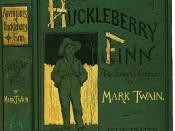
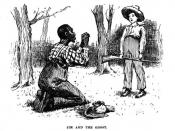
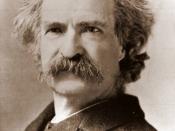
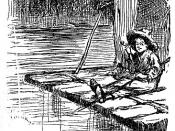
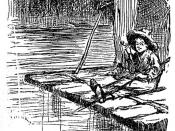

Greeat
great essay dealing with the racism ideas in Huckleberry Finn
0 out of 0 people found this comment useful.